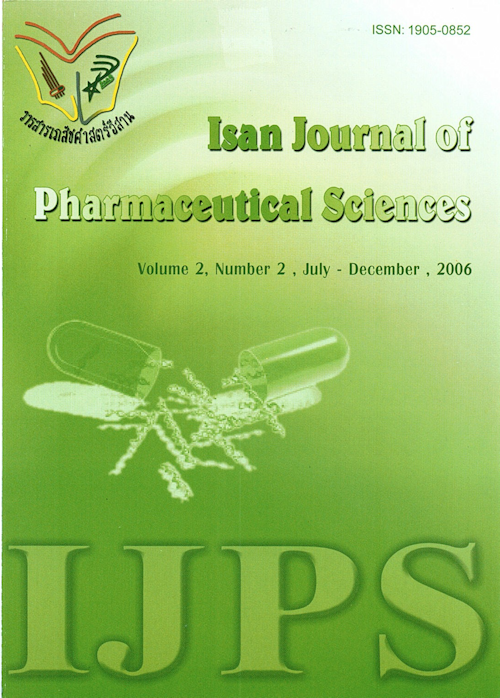Statin Utilization and Its Cost Effectiveness in Patient with Type 2 Diabetes
Main Article Content
Abstract
This study focused on statin therapy for primary prevention of the cardiovascular events in patients with type 2 diabetes in Thai-healthcare context. Three main objectives were studied and their results were summarized separately as follows.
A cost effectiveness analysis of statin therapy for primary prevention of cardiovascular events in patients with type 2 diabetes who were 50 to 65 ye.ar of age with LDL-C 115 to 149 mg/dl, was performed. The analyses revealed that this intervention is worthwhile with an incremental cost-effectiveness ratio of 20,608 Baht per QALY.
Academic detailing by a pharmacist was tested whether it can increase physicians’ prescribing rates on statin therapy and lipid profile monitoring in patients with type 2 diabetes. The effect of academic detailing was examined in three district hospitals. The numbers of patients who had lipid profile monitoring increased from 14-37% to 16-47%, but statin therapy for patients who did not have LDL-C goal achieved according to the Third Report of the National Cholesterol Education Program (NCEP III) was still low (0-37%).
Statin availability in hospital formulary before and after the National List of Essential Drug 2004 was released, was evaluated. Statin availability and lipid profile monitoring was available in all hospitals with 300 beds or more and about 71-84% in the hospitals with 60 beds or less, or those with 90 to 120 beds. For the hospitals indicating that they did not have statins in their hospital formularies, they reported that the process of including statins is underway and it should be done within 6 months. Thereby, at the present time statins are likely to be available in all levels of hospitals in Thailand.
In conclusion, although statin therapy for primary prevention of cardiovascular events in patients with type 2 diabetes is cost-effective in Thai-healthcare context, but statins prescribing for this population was still low. Academic detailing can not promote rates of statin prescribing and lipid profile monitoring.
Article Details
In the case that some parts are used by others The author must Confirm that obtaining permission to use some of the original authors. And must attach evidence That the permission has been included
References
Adams HP Jr, Adams RJ, Brott T, Del Zoppo GJ, Furlan A, Goldstein LB et al. (2003). Guideline for the early management of patients with ischemic stroke: A scientific statement from the stroke council of the American stroke. Stroke, 34, pp. 1056-1083.
American Diabetes Association. (2002). Management of dyslipidemia in adult with diabetes (Position Statement). Diabetes Care, 25, pp. 74-77.
Antman EM, An be DT, Armstrong PW, Bates ER, Green LA, Hand M et al. (2004). ACC/ AHA guideline for the management of ST-elevation myocardial infarction: Executive summary. A report of the American College of Cardiology/ American Heart Association Task Force on Practice Guidelines (Committee to revise the 1999 guideline for the management of patients with acute myocardial infarction). Circulation, 110, pp. 588-636.
Blake GJ, Ridker PM, Kuntz KM. (2003). Potential cost-effectiveness of C-Reactive protein screening followed by targeted statin therapy for the primary prevention of cardiovascular disease among patients without overt hyperlipidemia. The American Journal of Medicine, 114, pp. 485-494.
Braunwald E, Antman EM, Beasley JW, Califf RM, Cheitlin MD, Hochman JS et al. (2002). ACC/ AHA 2002 guideline update for the management of patients with unstable angina and non-ST segment elevation myocardial infarction: Summary article. A report of the American College of Cardiology/ American Heart Association Task Force on Practice Guidelines (Committee on the management of patients with unstable angina). Journal of the American College of Cardiology, 40, pp. 1366-1374.
CAPRIE Steering Committee. (1998). A randomized, blind, trial of clopidogrel versus aspirin in patients at risk of ischaemic events (CAPRIE). The Lancet, 348, pp. 1329-1337.
Expert Panel on Detection, Evaluation and Treatment of High Blood Cholesterol in Adults. (2001). Executive summary of the Third Report of the National Cholesterol Education Program (NCEP) Expert Panel on Detection, Evaluation and Treatment of High Blood Cholesterol in Adults (Adult Treatment Panel III). Journal of the American Medical Association, 285, pp. 2486-2497.
Haffner SM, Seppo Lehto, Tapani Ronnemaa, Kalevi Pyorala, Markku Laakso. (1999). Mortality from coronary heart disease in subjects with type 2 diabetes and in nondiabetes subjects without prior myocardial infarction. The New England Journal of Medicine, 339, pp. 229-234.
Heart Protecting Study Collaborative Group. (2002). MRC/BHF Heart protection study of cholesterol lowering with simvastatin in 205,036 high risk individuals: a randomized placebo-controlled trial. The Lancet, 360, pp. 7-22.
Sacks FM, Pfeffer MA, Moye LA, Rouleau JL, Rutherford ID, Cole TG et al. (1996). The effect of pravastatin on coronary events after myocardial infarction in patients with average cholesterol levels. The New England Journal of Medicine, 335, pp. 1001-1009.
Sheri LM, David HF, Jeffrey AJ. (2000). The impact of diabetes and co-morbidity on health-related quality of life: finding from the 1996-97 national population health survey. National Library Canada.
The Long-term Intervention with Pravastatin in Ischemic Disease (LIPID) study group. (1998). Prevention of cardiovascular events and death with pravastatin in patients with coronary heart disease and a broad range of initial cholesterol levels. The New England Journal of Medicine, 339, pp. 1349-1357.
The Scandinavian Simvastatin Survival Study (4S). (1994). Randomised trial of cholesterol lowering in 4,444 patients with coronary heart disease. The Lancet, 344, pp. 1383-1389.


